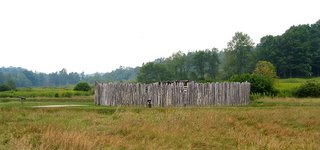George Washington had fired the shots which started the conflict still known in America as the French and Indian War. Two years of fighting in the backwoods of North America were to intervene before France and England declared hostilities officially. (Source: Plains of Abraham)However, before the fateful shots were fired, the French had been ratcheting up the tensions in North America:
Yet another and still more aggressive Governor-General had succeeded in Canada. This was the Marquis de Duquesne, who, in the spring of 1753, sent one of his toughest wilderness officers, Marin, at the head of fifteen hundred Canadians and Indians on an expedition from Fort Presqu'ile, the French strongpoint half-way along Lake Erie. ...they built Fort Le Boeuf...he (Marin) was succeeded by Legardeur de St. Pierre, who retired as autumn closed in, with most of the remaining force, to Fort Le Boeuf (present-day Pennsylvania). (Source: Plains of Abraham)
In the spring of 1754, George Washington was sent to force the French from British territory. Washington had orders from Governor Dinwiddie, who had orders from King George II to stop the encroachment:
If you shall find that any number of persons shall presume to erect any fort or forts within the limit of our province of Virginia, you are first to require of them peaceably to depart; and if notwithstanding your admonitions they do still endeavor to carry out any such unlawful and unjustifiable designs, we do hereby strictly charge and command you to drive them off by force of arms. [Orders of King George II written 28 August 1753 (source)]
On May 28, 1754, at what is now known as the Battle of Jumonville Glen, Washington turned the tables on the French and their planned ambush:[Source: Our Country by Lossing, 1875]
Washington took the initiative and bested Joseph Coulon de Jumonville, who died in the conflict.
After the battle:
[Washington] retreated back to Fort Necessity. Offering up his own horse as a pack animal, and ordering his fellow officers to do the same, yoking the Virginians, already on half rations because of the failure of the commissariat, to his nine swivel guns, the little force crawled back through the mud. The men of Mackay's (Captain James Mackay) independent company did not raise a finger to help. Washington's exhausted men had three days in which to ready their stockade for defence. His as yet unpractised military mind had chosen ill. Fort Necessity lay in the soggy bottom of a clearing, commanded by three hillocks within musket shot. He had four hundred men, and the French, when they marched out of the forest, had eight hundred. (Source: Plains of Abraham)
Jumonville's older brother led the French and soon retaliated and forced Washington to surrender at Fort Necessity on July 4, 1754.
He (Washington) had to leave behind two hostages against the return of the prisoners taken in his first skirmish in May, one of whom was a Captain Robert Stobo. The arrangement was later repudiated by Dinwiddie, who claimed the prisoners belonged to the colony and not to Washington, and Stobo had to remain in French captivity for five years. Mark his name well. He was to play a vital part under Wolfe at Quebec. (Source: Plains of Abraham)
The articles of capitulation of Fort Necessity can be found here.
The pictures were taken at Fort Necessity and were originally published here.
A chronological chart of events can be found here.



















No comments:
Post a Comment